Anshe Chung (picture from Rik Riel’s Flickr stream) spoke live from China at the grand opening celebration for the new Non-profit Commons island in Second Life. Anshe expressed her passion for using virtual worlds to connect globally.
Anshe Chung is SL’s first millionaire, a global metaverse entrepreneur, and donor of the island and buildings that house the NPC. Anshe described some of her own early experiences in virtual worlds and the power of the immersive social experience. She has seen virtual worlds and the internet enable people, previously forgotten and disconnected, to become connected to a global economy, and to meet other people on a more even footing. She talked about how people isolated from the world economy use rural internet cafes in China to socialize globally and make things of value in in virtual worlds.
Anshe, through her own portals on Second Life and other ventures, has been responsible for getting a vast number of people involved virtual worlds. She explained that she hoped the Non-profit Commons in SL could extend this process of finding new ways to connect technically, socially and emotionally to the members of non-profits.
Connecting Virtually: What makes the experience in Second Life so compelling?
Christian Renaud of Cisco uses the term “networked virtual environments” in the blog description of Cisco’s new Virtual Worlds Blog saying:
We believe that these environments offer an excellent new tool in our collaboration toolbox, alongside established technologies like IP Telephony, Web Collaboration, and Telepresence.
And, in my view, the time is just around the corner when “networked virtual environments” will be the tool par excellence for global collaboration and much more. This is one of the founding inspirations of the Ugotrade blog.
SuezanneC Baskerville, makes a fascinating comment to Christian’s post drawn from her recent post Virtual World moguls meet across shared Surface in Metaverse Poker Room. She suggests “that it would be interesting to see Linden Lab link it’s San Francisco and Boston offices using Cisco’s Telepresence system.” Christian’s Renaud’s response to her comment is also a must read. He notes his own experiences with wall sized video conferences, “bumping into colleagues in our break-rooms in our Technology Center offices in Raleigh and San Jose…..”
But, of special interest to me, is Christian’s comment on one of the key aspects of virtual worlds or “verses” as he likes to call them.
The “serendipity” of virtual worlds is a key part of the paradigm shift that Second Life has brought to “over the network interaction.” Christian explains:
One of the areas that we are constantly striving to improve is how you make an ‘over the network’ interaction as valuable and signal-rich as an ‘over the desk’ interaction. One of those variables, which is a key attribute of virtual worlds (or ‘verses, as I call them), is serendipity. I can’t very well bump into you on a telephone call, or (other than your example above) on a Telepresence call, however I can bump into your avatar in Second Life easily. How do we facilitate this serendipity, perhaps even nudge you in the direction of someone with shared interests? Food for thought.
“The Serendipity of Second Life”
And, just to press home a point on this “magic of Second Life,” I had a serendipitous encounter on SL only minutes after reading Christian’s comment. I bumped into a rising Japanese Electro/techno/house star, Shingo, on Virgin EMI Music Japan.
Risso Little is new to Second Life. I had gone to Virgin EMI Music Japan to follow up on some interesting posts on Japanese sims by my friend Al Kronos. While we were chatting an earthquake struck Tokyo, and my new found friend’s eighth floor apartment started to shake. I had just gone to his My Space. And, I was listening to one of his excellent tracks when this happened. (Click here to listen)
Well to make a long story short, Rizzo and I were very relieved when the shake up was over. I offered to take him shopping (yes, I know, what was I thinking? “I shop therefore I am”). But, nevertheless in a few short hours Shingo gave me an introduction to some Japanese areas in Second Life. And, I took him around some of the American and European sims. Here we are chatting with a group of Japanese fashionistas waiting to earn Linden dollars modeling dresses in panels. Later, I connected Rizzo Little to Nat Mandelbrot (of Cruxy Player fame) who is pioneering new ways for musicians to extend the experience of their music in Second Life.
Thinking on a global scale – Second Life is not “empty space.”
The casual drop-in approach to Second Life taken by some main stream journalists, and their resulting cursory view from afar, has created a lot of misunderstanding in recent months about how Second Life works to connect people globally, in completely new ways, for business, pleasure and social change.
Story Geek recently wrote an excellent post pointing out that stories in “Wired and the L.A. Times have deemed Second Life (SL) a failure because of it being empty” misunderstand this new virtual landscape that appears empty to a casual glance even though it is actually teeming with life and economic activity.
Story Geek gives an excellent analysis of why a high level glance at a virtual environment misinforms the observer much the way such a high level glimpse might in the real world perceive Canada as empty. And so, Story Geek quips, “Maybe all businesses should pull out of Canada also.” Story Geek points out some of the specific ways that Second Life’s teeming economy and bustle of activity might not be apparent to a drop in observer. And, he points out:
by understanding the mechanics of the world you get a clearer picture of how the residents exist, inter-relate and consume.
Reflexive Architecture: Experiencing People in the Global Reaches of Virtual Space
3D Experience architect Keystone Bouchard is currently engaged in exploring through reflexive and responsive architecture new ways for people to experience other people’s presence in virtual space. As Story Geek noted, mis-perceptions of emptiness can arise in virtual environments for many reasons, e.g., because Second Life is an open 24/7 space with people arriving from multiple time zones at different times of the day.
In a Gallery of Reflexive Architecture, to be exhibited as part of the new Library Gallery exhibition on Info Island by the artslib group, Keystone is showcasing some of his work with scripter Fumon Kubo. Keystone has posted a video composite of several machinima pieces each describing a different installation in the gallery, such as Rippling Prims, Prim Decay, Sudden Space, Restless Spheres, Carvable Prims, Visible Traces, Moving Tiles, Interactive Glass, and The Cacoon. Some include sound as an integral part of the experience, which is best experienced first-hand (SLurl … subject to change).
The picture below is of Sudden Space.
Keystone explained to me:
One thing I’ve struggled with is the idea that people think sims are ‘always empty’ just because there wasn’t someone there the instant they visited. But in actuality, these places are flooded with people flowing through them. The difference is, we’re on a global scale now most websites are ‘empty’ most of the time too. So, I wanted to build in a system that illustrates that you’re not alone, a relatively low-impact way of measuring how spaces are used as well.
Keystone took me through the reflexive 3D experiences he has created. Here is a short selection of some of the comments he made.
Each one of us should have a different color and they follow our trails. Right now I have them set to last 2 hours so, we can see visible traces of people who have been here before us. I can already see in the first day this has been here that some of the corner installations are overlooked, so, its meaningful feedback
I’ve wondered how this one will behave with many avs present so far, its only been tested with 2 but, its created a nice little space for us where nothing was before.
On Demand Architecture = Prim Ripples.Carvable Prims
This explores the idea of avatar movement gradually ‘carving’ the architecture. Every time an avatar appraoches, the ‘wall’ elements move a slight bit away so, over time, the high traffic areas become larger.It was based on a conversation Theory Shaw and I had a while back one of those monumental ‘What If?’ conversation
Keystone and I discussed how reflexive 3D experience architecture will take on new value and meaning when it can be laced with data from the real world. The potential of virtual world/real world intergrations to provide a doorway to a sustainable future is a key theme on Ugotrade. And, I have discussed this many times, including here, here, and here in some depth.
We are on the cusp of virtual revolution that will shift the world away from models of communication, representation, and production that emerged in the industrial age.
In Second Life we are beginning to see Global initiatives like EOLUS One put together the kind of global collaboration that will make virtual environments the stage for planning, designing and managing real life buildings and cities in new collaborative and participatory ways. And once built, these cities will stream back into Virtual Worlds as data that is responsive to our needs and the needs of the environment.
Then 3D experience architecture will emerge as not only a beautiful expression of a new era of global communication and collaboration, but as a a tool par excellence for benefiting communities and people, and creating a sustainable future.
Thinking Globally: How Can Developing Countries Benefit from Virtual Worlds?
An important question that came up at the non-profit commons launch was how non-profits in developing countries can utilize virtual worlds. This is a topic I discussed with Alanagh Recreant of Uthango Social Investments in this post. Also see this interesting article on Uthango’s work in the South African national newspaper Cape Argus. And, please see Uthango’s new blog, Africa’s Second life , Our Virtual Reality, to learn about the first event of Uthango’s African Round Table Initiative, in Second Life, Aug 24th.
These are exciting times for Non-profits on Second Life and the fact that facilitating developing countries participation in virtual worlds seems high on the agenda is very encouraging.
MacArthur funding a non-profit track (see press release) at the SLCC convention which Rik Riel will be blogging.
The Grand Opening of Non-profit Commons on Second Life
There are some excellent blogs on the non-profit commons launch. Ruby Sinreich live blogged it. And, Rik Riel has posted some great pictures on his blog and more here. Susan Tenby (avatar Glitteratica Cookie) talked about TechSoup’s work in Second Life – 300 group members and thousands of avatars have come to their weekly meetings. Coughran Mayo from Preferred Family Healthcare spoke (via Skype), and Glitteractica Cookie (Susan Tenby of TechSoup), Jeska Linden (NP liaison for Linden Labs), and Anshe Chung live from China.
Evonne Heyning (avatar In Kenzo) elaborated on some of the specific ways the Non-profit commons on Second Life will be a portal bootstrapping the non-profit process on Second Life with efforts like, an “office in a box,” to help non-profits get up to speed fast on Second Life. Go visit nonprofitcommons.org on the web and in Second Life:
slurl.com/secondlife/Plush%20Nonprofit%20Commons/130/125/22/ to find out more.
After the panel there was a tour of the 32 nonprofits who have offices at NPC. Here I am at Yehoodi, the swing dance society run by Rik who is DJing real time. The swing music was great. And, I didn’t have to wait long before I landed a very dashing dance partner -Dore Junot (film maker Salvador Luna in RL) who I gather was the video guru for the mixed reality panel (photo below of the live event, “Jeska and Susan in two worlds,” from net2photos flickr stream)

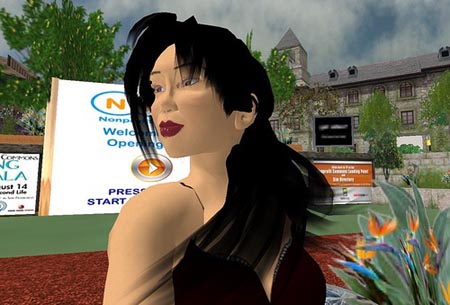
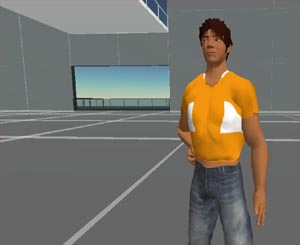

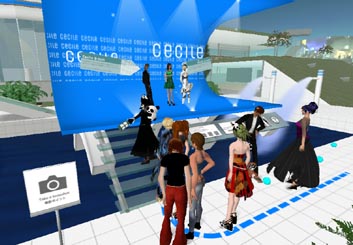
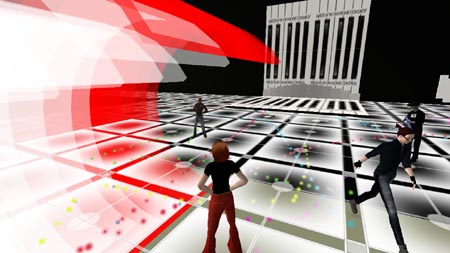
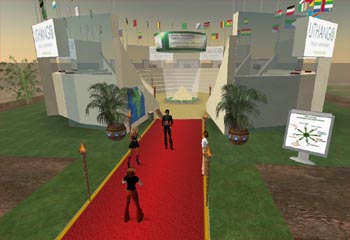
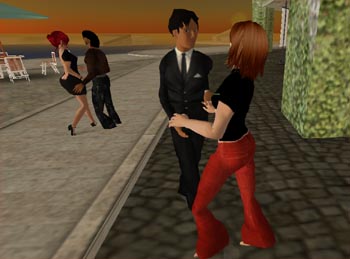
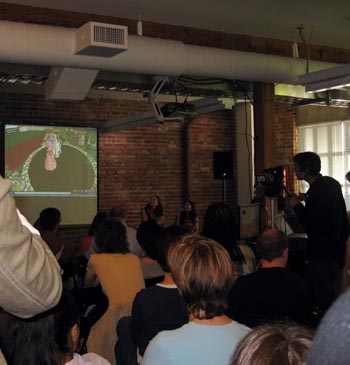
Sun, Aug 19, 2007